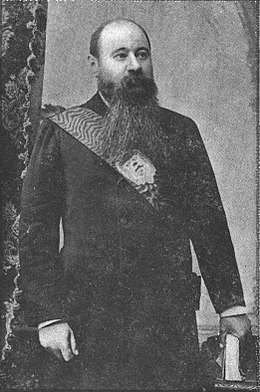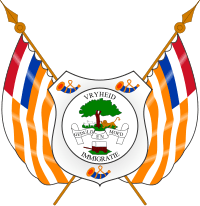Martinus Theunis Steyn
| Martinus Theunis Steyn | |
|---|---|
 | |
| 6th State President of the Orange Free State | |
|
In office 4 March 1896 – 30 May 1902 | |
| Preceded by | Francis William Reitz |
| Succeeded by | Christiaan de Wet (acting) |
| Personal details | |
| Born |
2 October 1857 Winburg, Orange Free State |
| Died |
28 November 1916 (aged 58) Bloemfontein, Orange Free State Province, Union of South Africa |
| Political party |
South African Party National Party |
| Spouse(s) | Rachel Isabella (Tibbie) Fraser |
| Alma mater | Grey College, Leiden University |
| Occupation | Lawyer |
Martinus (or Marthinus) Theunis Steyn (2 October 1857 – 28 November 1916) was a South African lawyer, politician, and statesman, sixth and last president of the independent Orange Free State from 1896 to 1902.
Early life
The Steyn family lived near Winburg on the farm Josephinesdal. Steyn was born on 2 October 1857 on the farm Rietfontein near Winburg in the Orange Free State.[1] His father Marthinus (known as Marthinus 'blinkstewels') was away from home after the death of his own father, to assist his mother on a three month long round trip from Winburg to Swellendam in the Cape Colony. As Cecilia, Steyn's mother, was pregnant with Marthinus Theunis, they thought it safer for her to stay with her sister Gertruida, who was married to Theunis Wessels, a farmer at Rietfontein. Steyn was meant to be named only Marthinus after his father, but because of the good care that Theunis and Gertruida took during Cecilia's pregnancy, Steyn was named both after his father Marthinus and his uncle Theunis. In later years his family always called him Theunis.
During the Basotho War of 1858, the Steyns were driven from their farm and lost almost everything. After the death of Steyn's two grandfathers, his Wessels grandmother convinced his father to buy his own farm. They bought the farm Suurfontein/Zuurfontein, on the Modder River, about 13 miles from Bloemfontein. It is on this farm that Steyn spent most of his youth, and experienced the open and free spaces of the Free State.
Steyn started his school years in a small farm school, on the farm Rooiwal. The school was forty minutes away by horse and the teacher was Mr. Wiggins, who taught in English. Another Basoeto War started in 1864, disrupting the family, and causing Theunis and his brother Tewie to stay with their grandmother in Wessels, where they attended a small grammar school briefly; afterwards they were sent to Grey College.
At the age of 16, he left school with his brother Tewie to farm on Zuurfontein.[2] Steyn's family lived right across from the then president of the Free State, J.H. Brand, in Bloemfontein. The family socialized with other groups of Dutch families. The Steyn home in Bloemfontein, Green Lodge, was the meeting place for the young people of Bloemfontein.[3] The house was open for everybody; from the Fichardts of German origin, to the English speaking Robertses, to the Jewish Baumans, to English speaking Afrikaners, like President Brand, as well as the Dutch community.
Studies
After finishing his studies at Grey College, and after farming for four years on Suurfontein/Zuurfontein a visit by Judge James Buchanan, a member of the Orange Free State High Court[4] changed Steyn's direction from farming towards further studies in law. According to Judge Buchanan's daughter, he was set on convincing Steyn's father that they needed to send Steyn to the Netherlands to study law at the Rijks University in Leiden, Leiden University.[5]
Steyn and his friend Harry Vels left in May 1877 on the Dunrobin Castle from Port Elizabeth for Cape Town and from there to Europe. In Cape Town more passengers, including Rev. Colin Fraser and his family, on his way to Scotland as delegate for the Free State Church at the Pan-Presbyterian Council (now known as the World Alliance of Reformed Churches), (accompanied by the 12 year old Tibbie Fraser, later to become the wife of Steyn); there was also a South African Republic Government delegation consisting of Paul Kruger, the then vice president of the Zuid-Afrikaanse Republiek, E.J.P. Jorrison, the State Attorney and their secretary, Eduard Bok, on their way to England to lay a formal protest against the proclamation of sir Theophilus Shepstone that there will come an end to the South African Republic.
Steyn and Vels did preparatory studies under W.F.P. Enklaar and Dr. B. Wisselink at the Gymnasium in Deventer. In September 1879 they would have written their admission exams for the Leiden University, however, they decided to move to England. This decision was made as they needed an English certificate and training to be allowed to practice law in South Africa. Steyn wrote his admission exam in January 1880 for the Inner Temple in London. Steyn was called to the English bar in November 1882 and shortly afterwards returned to South Africa.
Law career
After his return to South Africa he set up practice as barrister in Bloemfontein. In 1889 Steyn was appointed state attorney of the Orange Free State. A few months afterwards he became second puisne judge, and in 1893 first puisne judge of the high court. His decisions won him a reputation for ability and sound judgment.[6]
Early political career
Marthinus 'blinkstewels', father of Steyn, as member of the Executive Council, regularly accompanied State President Johannes Brand on visits to determine the needs of the people of the Orange Free State. Steyn, as a lover of books who even took a small library of books with him during the Anglo-Boer War, was well read. Through his father and visits home, he kept in contact with the latest political views, activities and needs of the people.
Steyn's first interest in the politics of the day was initiated by the unlawful annexation of the diamond fields in the Kimberley area by the British government in 1871. After the claims of the Griqua captain, Nicolaas Waterboer, Britain, driven by its "New Imperialism" agreed that the Cape Governor, Sir Henry Barkly, could annex the land, in direct conflict to the wishes of the Cape Colony Government and the Orange River Convention (Bloemfontein Convention) of 1854. The resolution of the payment, with a mere £90, 000 and the building of a railway to the Orange Free State by the British Government in 1876, was not acceptable to the people.
President of the Orange Free State
In 1895, upon the resignation of state president Francis William Reitz, Steyn was the candidate of the pan-Dutch party for the vacant post. The election was held in February 1896 and resulted in a decisive victory for Steyn, who assumed office as president.[6] The beginning of the Second Boer War, in 1899, caused Steyn to link the fortunes of his state with those of the Transvaal, allying with it against the British Empire. While the Orange Free State was under British occupation, Steyn ran his government from the field, playing a key role in continuing Boer resistance and the coordination of guerrilla warfare that made up most of the Boer War from 1900 onwards.
Regarded as one of the most irreconcilable of the Boer leaders, he took part, however, in the preliminary peace negotiations at Klerksdorp in April 1902 but was prevented by illness from signing the Treaty of Vereeniging at Pretoria on 31 May 1902.[6] The treaty ended the independence of the Orange Free State and Steyn's term as its president.
After 1902
By 1902 Steyn was suffering from myasthenia gravis brought on by his constant exertions; and in July 1902 he sailed for Europe, where he remained until the autumn of 1904. He then took the oath of allegiance to the British crown, and returning to South Africa partially restored to health resumed an active participation in politics. In 1908–1909 he was vice-president of the Closer Union Convention, where he was distinguished for his statesmanlike and conciliatory attitude, while maintaining the rights of the Boer community.[6]
While addressing a meeting in Bloemfontein in November 1916, he collapsed and died of a heart attack, at only 59.
Legacy
Afrikaner Bond
From early on, Steyn, along with many other prominent Freestaters, came under the influence of a clever German, Carl Borckenhagen, the editor of the Bloemfontein Express newspaper, and in 1881 he had joined Borckenhagen in founding the Afrikaner Bond.[7]
South African Party
In the South African Union he was a co-founder of the South African Party which he left in 1914 with James Barry Munnik Hertzog and Christiaan Rudolf de Wet to found the National Party.
National Party
Steyn, James Barry Munnik Hertzog and Christiaan Rudolf de Wet co-founded the National Party in 1914.
The C&N Oranje Meisieskool
The Anglo-Boer War and the great loss in woman and children was a driving force behind the origin of the C&N Oranje Meisieskool, an originally Dutch and now Afrikaans girls school, that was initiated by Steyn. The school opened its doors in 1907.
National Woman's Memorial
The National Women’s Memorial, the first monument in the world dedicated to women and children, was unveiled on 16 December 1913 and was initiated by the ideals of Steyn and the family friend, Emily Hobhouse.[8] The sculptor Anton van Wouw and the architect Frans Soff did the design for the monument.
Descendants
Steyn has a descendant who practices as a lawyer in Johannesburg. His granddaughter was the well-known South African actress Nerina Ferreira.[9]
Quote
"I would rather lose the independence of the Free State with honour than retain it with dishonour". Stated before he dispatched the ultimatum (starting the Anglo-boer War) to the United Kingdom.
References
- ↑ Van der Merwe, NJ (1921) Marthinus Theunis Steyn. 'n Lewensbeskrywing. Part 1. De Nationale Press Beperkt, Cape Town.
- ↑ Van Schoor, MCE (2009) Marthinus Theunis Steyn. Regsman, staatsman en volksman. Protea Boekhuis, Pretoria.
- ↑ Truter E (1997) Tibbie: Rachel Isabella Steyn 1865-1955: Haar lewe was haar boodskap. Human and Rosseau. Kaapstad.
- ↑ Zimmermanm R and Visser DP (1996) Southern Cross: Civil Law and Common Law in South Africa. Clarendon Press, Oxford.
- ↑ "Steyn, Marthinus Theunis, South Africa, Dutch Reformed Church". www.dacb.org. Archived from the original on 24 March 2016. Retrieved 17 March 2016.
- 1 2 3 4

- ↑ "Orange Free State". Encyclopædia Britannica. 20 (11th ed.). 1911. p. 157.
- ↑ http://vrouemonument.co.za/
- ↑ "Nerina Ferreira verskyn weer op die Verhoog" (June 1, 1969) Die Burger, Cape Town
External links
| Wikimedia Commons has media related to Martinus Theunis Steyn. |
| Wikisource has original text related to this article: |
